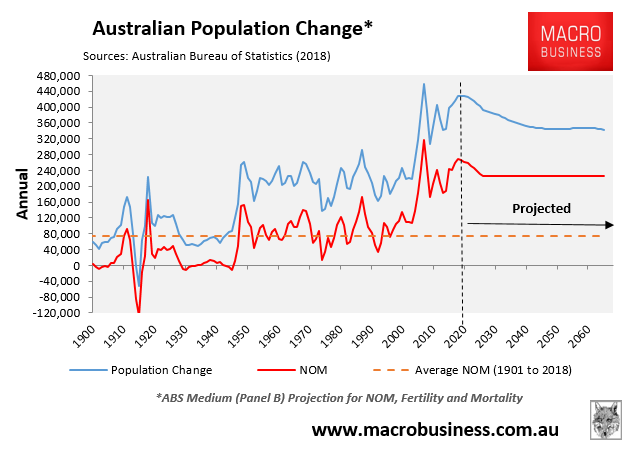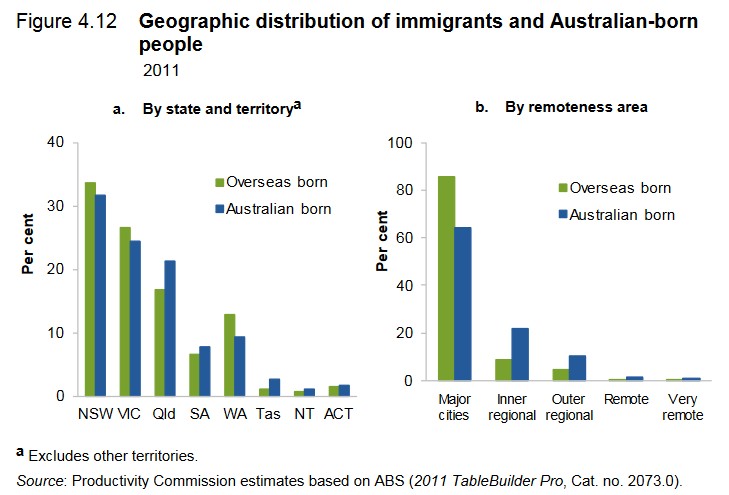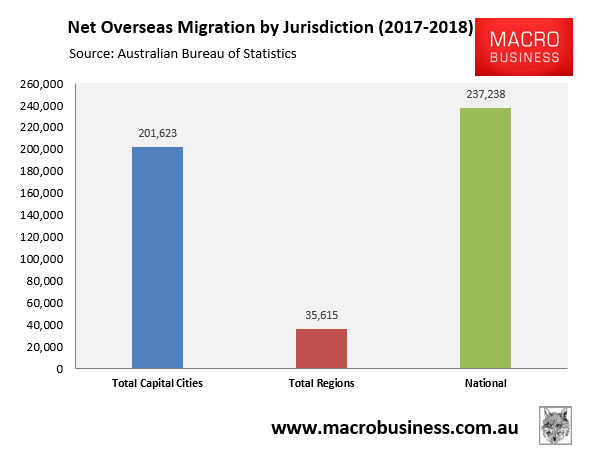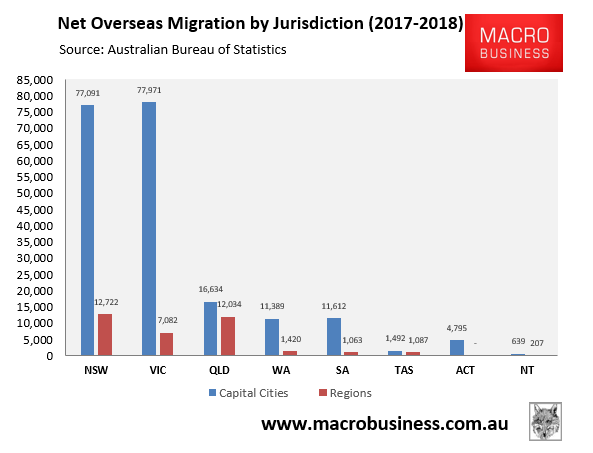Since the Coalition first announced its ‘migrants to the bush’ visas to divert population growth away from the major cities, MB has labelled it a policy smokescreen aimed at diverting attention away from the main issue: that immigration is simply too high at roughly triple the historical average:

One hundred years of empirical evidence shows that migrants overwhelmingly choose to live in the major city, as illustrated by the Productivity Commission’s 2016 Migrant Intake into Australia report:

The latest Australian Census similarly revealed that 86% of new migrants (1.11 million) in the five years to 2016 settled in the capital cities, compared with only 14% (187,000) that settled in regional areas.
Finally, the most recent migrant settlement data from the Australian Bureau of Statistics showed that 85% of migrants settled in Australia’s capital cities in 2017-18, with 65% of total migrants settling in Sydney and Melbourne:


With this background in mind, SBS News yesterday reported that the Morrison Government has trimmed the number of subclass 189 skilled independent visas – which allows holders full rights and privileges of a permanent resident from day one – in favour of regional visas:
Only 100 subclass 189 visa invitations were sent out in August 2019, which is a massive fall compared to the previous month. In July 1000 invites had been sent out…
Melbourne-based migration expert Rohit Mohan believes that the government looks more focused on pushing migrants to regional areas.
“The current invitation round in August 2019 is suggesting the fact that the government is tightening direct permanent residency under independent sub-class 189. Instead, the government looks more focused on pushing migrants to regional areas. In coming days, we will see a shift to visa grants under subclass 491 and 494, which will restrict migrants to live and work in regional areas only,” Mr Mohan told SBS Hindi.
Subclass 494 and subclass 491 are the two new regional visas being introduced from November this year.
While these visa tweaks will direct a handful of migrants to regional areas, there is nothing to actually keep them there long-term. Based on past experience, most will inevitably head into the major cities once their mandatory time period in the regions has expired.
To highlight this point, recent ANU research of settlement patterns revealed that 60% of migrants that moved to Australia’s regions subsequently move to capital cities within five years:
An Australian National University study released Thursday found more than 60 per cent of migrants move to a capital city after about five years of living in a regional or remote location.
ANU material went as far as saying new migrants were “fleeing” regional Australia for better opportunities in the cities.
Australia has a number of visas that are designed to entice migrants to regional areas but the research suggests more needs to be done to keep them there.
ANU demographer Bernard Baffour told SBS News, “you can move migrants to areas, but you can’t force them to stay there”…
The study found Chinese-born migrants are more likely to settle in Sydney. Erin Chew of the Asian Australian Alliance said, “a lot of the Chinese people are city dwellers, so they want to live in [places] where there’s a huge concentration of their community”…
Elsewhere, Melbourne is the city of choice for most Indian-born migrants.
The empirical evidence also shows that state-based migration programs have been systemically exploited, with migrants temporarily settling in places like Tasmania and Canberra to qualify for permanent residency before moving to Sydney and Melbourne.
So, short of placing electronic tags on migrants, how can decentralisation be achieved in practice when it has failed repeatedly in the past, with the visa system systematically gamed?
Of course, there are also practical barriers with moving migrants to the regions, such as lack of water supply and jobs. But I will leave these for another day.

